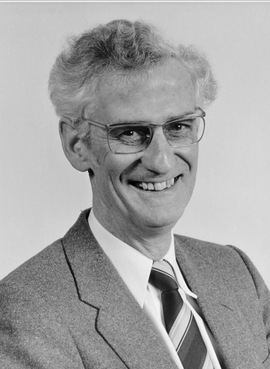J. Rodney Quayle facts for kids
Quick facts for kids
John Rodney (Rod) Quayle
FRS
|
|
|---|---|
 |
|
| Born | 1926 |
| Died | 2006 (aged 79–80) |
| Spouse(s) | Yvonne Sanderson |
| Children | 2 |
| Awards | Fellow of the Royal Society |
| Scientific career | |
| Theses |
|
| Doctoral advisors | Edward D. Hughes; Alexander R. Todd |
John Rodney Quayle (1926–2006) was a brilliant scientist who studied tiny living things called microbes. He was a microbial biochemist, which means he looked at the chemical processes inside these microbes. He taught at the University of Sheffield and later became the leader (Vice-Chancellor) of University of Bath. He was famous for studying how microbes use very simple carbon compounds for food and energy.
Contents
About Rod Quayle
Early Life and School
John Rodney Quayle, often called Rod, was born in Hoylake, Flintshire. When he was about five years old, he moved with his mother and brother to Cilcain. They lived with his grandparents, who helped support the family. He went to Alun Grammar School in Mold.
University Studies
In 1943, Rod won a special scholarship to go to university. He studied chemistry at the University College of North Wales, Bangor. He earned his first degree in 1946.
He then continued his studies to get a PhD, focusing on physical organic chemistry. After that, he moved to the University of Cambridge. There, he worked on understanding the special colored molecules found in Aphididae insects, also known as aphids. This research led to him earning a second PhD in 1952.
Family Life
In 1951, Rod Quayle married Yvonne Sanderson. They had two children, a son and a daughter. He passed away on February 26, 2006.
Rod Quayle's Career and Discoveries
Research in the USA and UK
After his studies in Cambridge, Rod Quayle moved to the University of California, Berkeley in the USA in 1953. For two years, he worked with another famous scientist, Melvin Calvin. They studied how plants make sugars. This work taught him how to use special radioactive forms of carbon dioxide to track chemical reactions very quickly. He learned how to find and identify the products of these reactions.
In 1955, he returned to the UK. He worked for the government's Tropical Products Institute, studying pyrethrin insecticides. However, he wanted to do more biochemistry research.
Focus on Microbes
By chance, he met Hans Kornberg and started working with him at Oxford University. They studied important chemical cycles in cells, like the glyoxylate cycle. Rod Quayle then changed his research focus. He started using the techniques he learned in the US to study methylotrophic bacteria. These are special bacteria that use very simple carbon compounds, like those with just one carbon atom, for their energy and growth. At that time, not much was known about how these microbes worked. This became the main focus of his research for many years.
In 1957, he became a lecturer in biochemistry at Oriel College, Oxford. In 1963, he moved to the University of Sheffield as a senior lecturer. By 1965, he became the West Riding Professor of Microbiology.
Understanding Microbial Pathways
Rod Quayle's research team used several methods to understand these microbes. They used radioactive labeling, which is like putting a tiny tracker on molecules to see where they go. They also isolated enzymes (special proteins that speed up chemical reactions) and used many analytical tools.
Through this work, they discovered how methylotrophic bacteria use different one-carbon compounds. These compounds included methane, methanol, formaldehyde, and carbon dioxide. They found out about four different ways these bacteria use the ribulose monophosphate pathway (RuMP pathway). They also discovered key parts of the serine cycle. Later, in the 1970s, his group found that single-celled fungi also used methanol in a new way, which they called the dihydroxyacetone cycle.
Helping Industry
From 1967, Rod Quayle advised the ICI company. ICI was working on a project called Pruteen. This project aimed to grow bacteria using methane to create animal feed. Rod suggested that using methanol instead of methane would be better. His advice was very important in developing this technology.
Leadership Roles
Rod Quayle also held several important leadership positions in universities. From 1974 to 1976, he was the Dean of the Faculty of Science at the University of Sheffield. From 1983 to 1992, he was the Vice-Chancellor of the University of Bath. His experience in applying science to real-world problems helped Bath University develop its applied science programs and research. He also advised the UK government on microbiology from 1985 to 1990. He retired in 1992.
Awards and Honors
Rod Quayle received many awards for his important work.
- In 1978, he was elected to the Royal Society, a very prestigious group of scientists. He also received the CIBA Medal and Prize from the Biochemical Society.
- He was given honorary doctorates from the University of Göttingen (1989), and from the Universities of Bath and Sheffield (1992).
- He served as president of the Society for General Microbiology from 1990 to 1993.
- In 1996, he was awarded an Honorary Fellowship by Bangor University.

